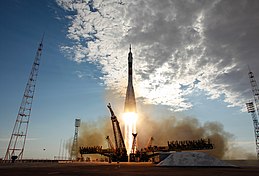Soyuz-TMA
 |
|
| Manufacturer | Korolev |
|---|---|
| Country of origin |
|
| Operator | Russian Federal Space Agency |
| Applications | Carry three cosmonauts to ISS and back |
| Specifications | |
| Design life | Up to six months docked to Space station |
| Regime | Low Earth orbit |
| Production | |
| Status | Retired (replaced by Soyuz TMA-M) |
| Launched | 22 |
| First launch | Soyuz TMA-1, 2002 |
| Last launch | Soyuz TMA-22, 2012 |
| Related spacecraft | |
| Derived from | Soyuz-TM |
| Derivatives | Soyuz TMA-M |
 |
|
| Manufacturer | Korolev |
|---|---|
| Country of origin |
|
| Operator | Russian Federal Space Agency |
| Applications | Carry three cosmonauts to ISS and back |
| Specifications | |
| Design life | Up to six months docked to Space station |
| Regime | Low Earth orbit |
| Production | |
| Status | Retired (replaced by Soyuz MS) |
| Launched | 20 |
| First launch | Soyuz TMA-01M, 2010 |
| Last launch | Soyuz TMA-20M, 2016 |
| Related spacecraft | |
| Derived from | Soyuz-TMA |
| Derivatives | Soyuz MS |
The Soyuz-TMA is a recent revision of the Soyuz spacecraft, superseded in 2010 by the Soyuz TMA-M. (T – транспортный – Transportnyi – meaning transport, M – модифицированный – Modifitsirovannyi – meaning modified, A – антропометрический, – Antropometricheskii meaning anthropometric). It is used by the Russian Federal Space Agency for human spaceflight. The spacecraft features several changes to accommodate requirements requested by NASA in order to service the International Space Station, including more latitude in the height and weight of the crew and improved parachute systems. It is also the first expendable vehicle to feature a "glass cockpit". Soyuz-TMA looks identical to the earlier Soyuz-TM spacecraft on the outside, but interior differences allow it to accommodate taller occupants with new adjustable crew couches.
A Soyuz spacecraft consists of three parts (from front to back):
The first two portions are habitable living space. By moving as much as possible into the orbital module, which does not have to be shielded or decelerated during atmospheric re-entry, the Soyuz three-part craft is both larger and lighter than the two-part Apollo spacecraft's command module. The Apollo command module had six cubic meters of living space and a mass of 5000 kg; the three-part Soyuz provided the same crew with nine cubic meters of living space, an airlock, and a service module for the mass of the Apollo capsule alone. This does not consider orbital module that could be used instead of LEM in Apollo.
Soyuz can carry up to three cosmonauts and provide life support for them for about 30 person days. The life support system provides a nitrogen/oxygen atmosphere at sea level partial pressures. The atmosphere is regenerated through KO2 cylinders, which absorb most of the CO2 and water produced by the crew and regenerates the oxygen, and LiOH cylinders which absorb leftover CO2.
...
Wikipedia
